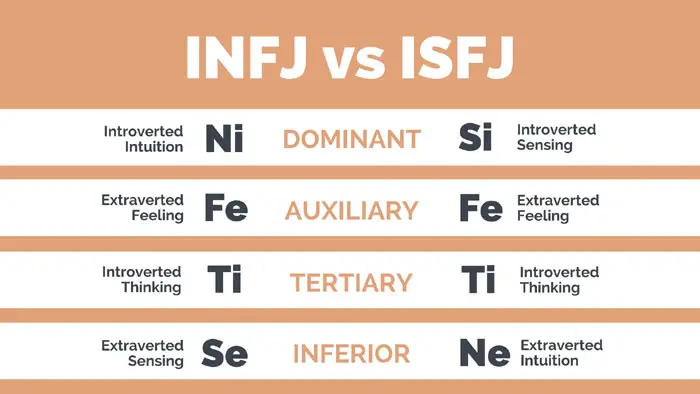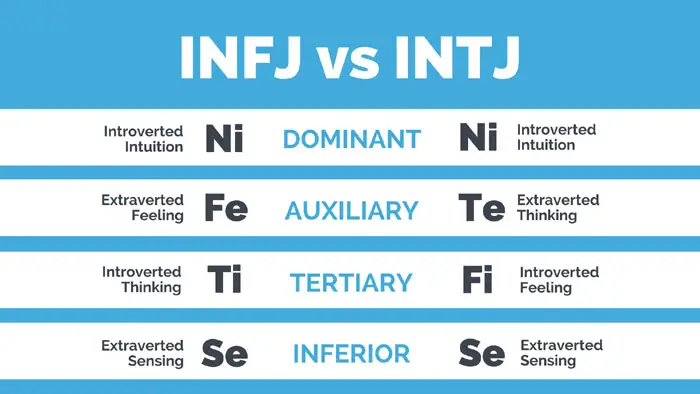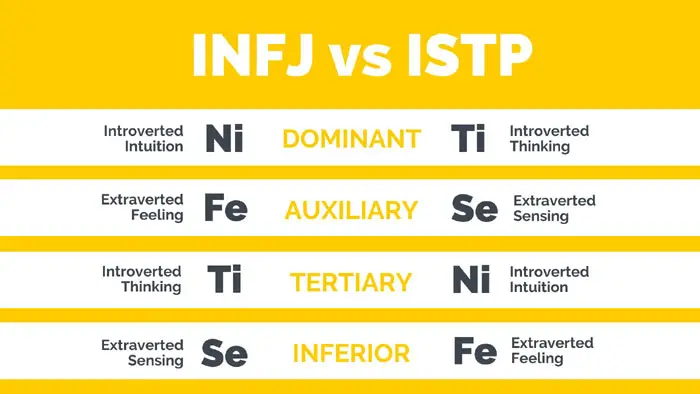Disclosure: There might be affiliate links on this page. As an Amazon Associate, I earn from qualifying purchases. This means I will earn a commission if you decide to make a purchase through my links but it will be at no additional cost to you.
Are you an INFJ struggling with the dreaded Ni-Ti loop?
Are you stuck in your head?
Do you think too much?
If so, you are not alone. The Ni-Ti loop is a common issue for many INFJs and it can cause a lot of stress and anxiety. But don’t worry – there are ways to break out of the loop and get back on track!
Before I share how to overcome the INFJ loop, let’s understand what a Ni-Ti loop is.
What Is the Ni-Ti Loop?
The Ni-Ti loop is a thought process wherein INFJs continuously use their dominant function of Introverted Intuition (Ni) and their tertiary function of Introverted Thinking (Ti) while bypassing their auxiliary function of Extraverted Feeling (Fe). This results in an endless cycle where INFJs are stuck in a loop, constantly analyzing and overthinking things.
INFJs often find themselves in a Ni-Ti loop when they withdraw from the outer world and stop interacting with other people. Their Ni drives them to seek inner truth and understanding, while their Ti helps them to analyze information in a logical way.
Ni and Ti work together by constantly asking and answering questions. Ni generates insights, while Ti checks whether the conclusions make sense to the individual. This can be healthy and a great tool for problem-solving, as long as INFJs balance it with their Fe function.
However, if the Fe function is ignored or suppressed, this can lead to analysis paralysis. INFJs will overlook external perspectives and get lost in their own thoughts. They develop abstract theories that may not have any direct relevance to their own lives or the lives of others.
Please read my article on INFJ Cognitive Functions to learn more about the four key cognitive functions that INFJs use.
What Does the INFJ Loop Look Like?
The Ni-Ti loop can trap INFJs in an endless cycle of rumination and self-doubt. It goes like this:
- INFJ has a question about something they don’t understand or are unsure about.
- The Ni function generates an answer or an idea.
- The INFJ uses the Ti function to analyze the insight and questions its validity and accuracy.
- The INFJ starts to doubt themselves and their insights.
- They try to find a better solution by thinking more but this just leads back to step 1 and the cycle repeats itself.
This is a never-ending loop because no matter how many ideas the Ni function generates, the Ti function will question them once again. An INFJ will never be able to come out with a perfect answer that satisfies the Ti.
This cycle continues until the INFJ is unable to come up with any new ideas or solutions, leading them to feel overwhelmed and discouraged.
A Real-Life Example of the Ni-Ti Loop in Action

To help you see what a Ni-Ti Loop feels like, here’s an illustrated example from my life.
Several years ago, while on vacation in New York with my friends, we decided to separate for the evening and have our own activities. As an introvert, this sounded ideal, but it ended up not being the case.
I wanted to watch a play called Orphans. But before I got a chance to buy the ticket, my Ti function stepped in and questioned me like a police officer: “Is this the right Broadway show to watch? Why do you want to watch Orphans? You rely heavily on subtitles when you watch English movies. What makes you think you can understand this play without any subtitles?”
So, I took a seat on one of the steps of TKTS, pondering what I should watch. I didn’t have a reason why I wanted to watch Orphans. I just wanted to watch it. It was a gut feeling, an idea presented by my Ni (Introverted Intuition). But, I was forced to justify my decision. And, I couldn’t depend on my friends to make a decision. They weren’t there, so I couldn’t activate my Fe (Extraverted Feeling)!
Don’t let Ti be your boss.
I sat there, going back and forth between Ni and Ti. Ni would come out with another show to watch, and Ti would try to analyze whether it was the best show to watch. I was so in my head that I didn’t realize I had been sitting in the cold for 30 to 45 minutes!
In the end, my Ni won. I came up with enough logical reasons to convince my Ti to watch Orphans, and the show became one of my highlights from my New York trip. But in hindsight, it’s kind of ridiculous because Ni (my dominant function) is supposed to be the leader. I don’t know why I needed to convince my Ti and ask his permission to watch a show.
Other Examples of Ni-Ti Loop
The Ni-Ti loop can manifest in different ways for INFJs. Here are a few common examples.
- Overthinking decisions: INFJ starts to second-guess their choices and analyze every outcome before deciding what to do.
- Getting stuck in analysis paralysis: The INFJ is unable to come up with solutions because they are too focused on understanding the problem and do not take any action.
- Anxious rumination: INFJ worries about the potential negative consequences of their actions or what other people might think.
- Not being able to move on from past mistakes: The INFJ rethinks a situation over and over again, trying to find some new perspective or a better way of doing something the next time.
- Perfectionism: INFJ constantly seeks perfection in their work and is unable to let go of something until it is perfect.
- Abstract and detached theories: The INFJ learns for the sake of learning and develops theories that have no practical benefits for themselves or other individuals.
Comparing the INFJ Loop With Other Similar Loops
The Ni-Ti loop is unique to the INFJ. Each of the 16 personality types has its own loops. For example, extroverts have their own extroverted loops. Even though ENFJs also have Ni and Ti in their cognitive function stack, they are more likely to get stuck in a Fe-Se loop (an extraverted loop) instead of a Ni-Ti loop (an introverted loop).
Ni-Ti loops are more similar to other introverted loops as they all involve an internal focus. But they are still different as each loop has its own set of unique dynamics. I will explain their key differences below so that you get a clearer picture of what a Ni-Ti loop is.
Ni-Ti Loop (INFJ) Vs Si-Ti Loop (ISFJ)
The Ni-Ti loop and Si-Ti loop share the same Ti function, making them very similar in terms of the amount of analysis involved.
However, Introverted Intuition (Ni) focuses on an ideal future, while Introverted Sensing (Si) focuses on past experiences. Therefore, when an INFJ gets stuck in the Ni-Ti loop, they are trying to reach their perfect vision through analysis. On the other hand, when an ISFJ gets stuck in a Si-Ti loop, they are attempting to analyze their negative past experience and understand why it happened.
Even though INFJ thinks about the past too, we think about the past to get better for the future. For example, I often try to rethink the communication I had with others to improve my words and sentences so that I can communicate with others with more clarity the next time I’m asked the same question. In contrast, the ISFJ is more likely to overanalyze negative past events and get stuck in them. Even for positive events, ISFJ can be stuck in a Si-Ti loop when they become perfectionistic and try to replicate the details of their past experiences.
If you are unsure which MBTI type you are, read my article on the differences between INFJ and ISFJ.
Ni-Ti Loop (INFJ) Vs Ni-Fi Loop (INTJ)
The Ni-Ti loop and Ni-Fi loops share the same Ni function, making them similar in terms of their idealistic view.
However, the Ni-Ti loop and Ni-Fi loops are drastically different. The Ti (Introverted Thinking) function of the INFJ focuses on the analysis of ideas and theories, while the Fi (Introverted Feeling) of the INTJ focuses on personal values and morals. The Ni-Ti loop makes an INFJ overly analytical and prone to overthinking, whereas the INTJ in a Ni-Fi loop makes snap judgments that are groundless.
When the usually objective INTJ gets into a Ni-Fi loop, they make decisions based on their emotions and subjective beliefs. If they believe something is right or wrong, their Ni creates more imagined scenarios to support their Fi beliefs. For example, if they believe the world is bad and people are out there to get them, they will come up with various conspiracy theories that may or may not be true at all.
If you are unsure which MBTI type you are, read my article on the differences between INFJ and INTJ.
Ni-Ti Loop (INFJ) Vs Ti-Ni Loop (ISTP)
The Ni-Ti loop and the Ti-Ni loop share the same functions, making both the INFJ and ISTP overly analytical and preventing them from taking action.
However, loops are initiated differently for INFJs and ISTPs. INFJs experience the Ni-Ti loop when they try to find the best solution. Their Ti function becomes overactive and excessively critical of their intuitive impulses. On the other hand, ISTPs experience the Ti-Ni loop when they feel uncertain about the future. Their fear of potential outcomes prevents them from progressing, even though they are skilled at finding logical solutions.
Problems that INFJs Encounter with a Ni-Ti Loop
- Procrastination: INFJs stuck in a Ni-Ti loop overanalyze their decisions and ideas, leading to procrastination or incompletion of tasks.
- Self-doubt: INFJs can become overly critical of themselves and their ideas, leading to a lack of confidence in their abilities.
- Overwhelm: INFJs may be too focused on the details and analysis. This causes them to miss the bigger picture and become overwhelmed by the task at hand.
- Anxiety: Overthinking and being too analytical can lead to increased feelings of anxiety and stress.
- Depression: An INFJ stuck in the Ni-Ti loop for a long time can start to feel a sense of hopelessness or depression.
- Loneliness: INFJs can become so lost in their own thoughts and ideas that they start to feel isolated from others.
- Detachment: INFJs may become too detached from reality, leading to a disconnection between their ideal vision and the actual world.
- Obsession: INFJs in search of the perfect answer may develop an unhealthy obsession with an idea or task.
How Do You Break Out of a Ni-Ti Loop?
1. Talk to someone and stay over-minded.
Engaging your Extraverted Feeling (Fe) function is the best way to escape the Ni-Ti loop since suppressing Fe is how you got stuck in the first place.
If possible, reach out and talk to someone who can provide an unbiased opinion and offer constructive criticism. If you are developing a theory, check with your target audience to see if it is of any use to them. This helps you gain clarity and a different perspective on your ideas or problems.
It is also important to remain open-minded. You may not agree with what others say completely, but listen anyway and do not shut yourself off from the conversation. They may say something that sparks new insights in you.
2. If there is no one to talk to, find a story of someone who has done it previously.
As an introvert myself, I know that some of you reading this are going to tell me that there is no one you can talk to or that you don’t feel like talking with others. Well, you don’t have to talk to someone in order to engage your Extraverted Feeling (Fe).
To solve a problem, you can search online for someone who has already gone through a similar situation and shared their experience. You can find solutions in different formats such as memoirs, blog posts, documentary shows, vlogs, or podcasts.
Reading, listening to, or watching the story of someone who has gone through a similar situation is an excellent way to draw inspiration for your own project or problem. It also helps you gain clarity on the steps necessary for you to move forward. This is better than getting stuck in an eternal rumination loop and trying to solve a problem by thinking harder about it.
3. Take frequent breaks and move around.
When you start feeling overwhelmed, it is important to step away from the problem and give your brain some time to process and rest. Taking short breaks throughout the day can help keep your mind clear and focused.
Perform activities that don’t engage your mind, such as going to the park for a walk, spending time with friends or family, listening to some nice music, or watching a comedy. Any activities that utilize your Fe (Extraverted Feeling) and Se (Extraverted Sensing) functions are great. Of course, some Se-based activities may result in over-indulgence and addiction, so you have to choose them wisely.
When you find yourself in a Ni-Ti loop, it can be helpful to physically move around, even if you want to continue thinking about the problem. By walking, you activate your Se function and also release stagnant energy that may be hindering fresh perspectives.
4. Use your Ti function only when necessary.
If you want to be a healthy INFJ, you have to keep your Ti function in check. You need to know when to use your Ti function and when not to.
I often find myself overthinking about where to eat, what to do for leisure, where to go, and what to buy. These mundane decisions do not require my Ti function. They can be made quickly and easily by intuition. Even if you make a wrong choice, these low-risk activities don’t affect your life much.
INFJs can benefit from using Ti, but it’s important to use it selectively for important tasks such as organizing information, analyzing complex data, and problem-solving. Avoid relying too heavily on it as it may result in getting stuck in a Ni-Ti loop.
5. Take action first and see what happens.
If you have trouble making a decision, don’t spend too much time analyzing the best path to take. Instead, take action first and observe the outcomes. If the outcome is not desirable, adjust your path accordingly.
I’m not suggesting you make impulsive decisions. I know some INFJs may hesitate to use their Se function out of fear of falling into a Se grip.
However, INFJs tend to spend a considerable amount of time on planning and are afraid of making mistakes. The problem with this is we end up procrastinating and not carrying out our plans at all.
Furthermore, the outcomes don’t always go according to our plans. Taking action first can help you gather more information and learn what works and what doesn’t, leading to better decision-making and planning.
Final Thoughts
Breaking out of the Ni-Ti loop is not always easy. Sometimes, we are so deeply entrenched in the INFJ loop that we cannot see a way out. But with some patience and self-compassion, breaking out of the INFJ loop is completely possible.
If you have a tendency to think too much, you may find my article on overthinking useful.











